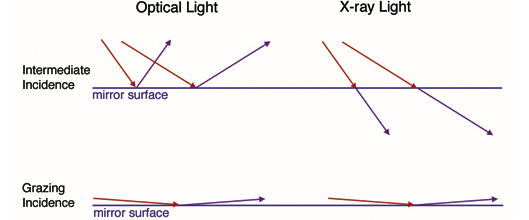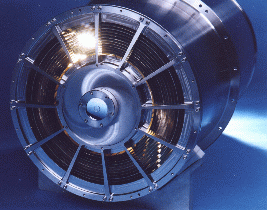X-Ray Telescope
The X-Ray Telescope (XRT) is one of Swift's two narrow-field instruments. Once the BAT detects a gamma-ray burst (GRB), the spacecraft slews to bring the new GRB into the XRT's field-of-view.How it Works
While X-rays can be focused (unlike gamma-rays), it is more difficult than focusing optical light. X-rays tend to pass through most things. For example, when a doctor takes an "X-ray" of your arm, she shoots X-rays through your arm onto a film. Some parts of your arm are more likely to stop those X-rays, like the bone. Other parts of your arm, like the muscles and soft tissue, don't stop the X-rays at all.
If you try to focus X-rays by putting a mirror directly in front of them, like you might focus optical light, the X-rays will pass right through the mirror! However, if those X-rays hit the mirror at a "grazing incidence", then they will be reflected. Grazing incidence means that the X-rays hit the mirror at an angle nearly parallel to the mirror.

Illustration showing what happens when an optical photon and X-ray photon encounter a mirror at a normal and grazing incidence. (Credit: NASA)
This means that to focus X-rays, an X-ray telescope must use mirrors that lie nearly parallel to the telescope's line-of-sight. These mirrors are nested, one inside another to cover as much area as possible. The XRT mirrors were originally built and tested for use on the JET-X program.

The mirrors which will be used to focus X-rays onto the XRT CCD. (Credit: NASA)
X-rays coming into the XRT are focused onto a state-of-the-art CCD, which was originally designed for the XMM-Newton EPIC telescope. The CCD registers the time and energy of incoming X-rays.
Science
The XRT refines the BAT localization to 5 arcsecond accuracy, and measures fluxes, spectra, and light curves of GRBs and afterglows. Emission absorption features in the X-ray spectra may reveal information about the material surrounding the GRB source. Redshift measurements from the XRT spectra provide distances to observed GRBs. This is particularly exciting for the class of short GRBs (see "About GRBs"), since to-date there have been no redshift measurements for GRBs in this class.

The XRT subsystem in the cleanroom with technicians preparing it for integration and testing (Credit: NASA)



